Overview
- Brief Narrative
- Charcoal drawing created by Alfred Glück in 1945-46 in the Hackensecke displaced persons camp in Germany. While at the Bergen Belsen DP camp, Alfred was encouraged by a Czech officer working for UNRRA to make drawings depicting the things he had witnessed during the war. In 1939, eighteen year old Alfred had left Vienna after the annexation of Austria by Nazi Germany in March 1938. He went to Germany to receive agricultural training at a Hechalutz hachshara in preparation for emigration to Palestine. In 1940, he was sent with other group members to Denmark to work as an agricultural laborer on Danish farms. In 1943, he joined a Hechalutz cell, Der Neue Weg, which had a plan to emigrate illegally to Palestine. The young men stowed away on freight railcars leaving Denmark for Turkey. Alfred was caught by the Germans on the Swiss-German border and sent to Auschwitz concentration camp, and then to Jaworno subcamp. In early 1945, he underwent two death marches, first to Buchenwald, and then to Bissengen, where he was freed by French soldiers. He settled briefly in Hamburg, then went to the UNRRA displaced persons camp in Bergen Belsen. In 1946, Alfred emigrated to Palestine. The drawing was given to Mordecai E. Schwartz, a former US Army soldier, who served as the Area Director for the United Nations Relief and Rehabilitation Administration (UNRRA) from 1945-1948, when UNRRA was deactivated.
- Date
-
creation:
after 1945 May-1946
- Geography
-
creation:
Hasenhecke (Displaced persons camp);
Kassel (Germany)
- Credit Line
- United States Holocaust Memorial Museum Collection, Gift of Mordecai E. Schwartz
- Signature
- front, lower right corner, charcoal : Alfred Glück
- Contributor
-
Artist:
Alfred Glück
Subject: Alfred Glück
Subject: Mordecai E. Schwartz
- Biography
-
Alfred Glück was born in 1921 in Vienna, Austria, to a Jewish family. Following the annexation of Austria by Nazi Germany in March 1938, Alfred left for a hachsharah of Hachsharah of Hechalutz in Guringshoff, Germany, to obtain agricultural training in preparation for his eventual emigration to Palestine. In 1940, the organization sent him to Denmark under a special agreement with the Danish government allowing young German Jews to come as agricultural workers to work for Danish farmers. In 1943, Alfred joined a small group of Hechalutz, Der Neue Weg, which planned to illegally travel to Palestine by way of Turkey. The plan called for the youngsters to hide under train cars transporting goods from Denmark to Turkey. Alfred was captured by the Germans on the border between Switzerland and Germany. He was sent to Auschwitz concentration camp and assigned to subcamp Jaworzno. In 1945, the inmates are forced on a death march to Buchenwald, where Alfred meets a group of Danish police officers incarcerated there. They shared the extra food rations they receive at camp as well as the care packages they get from the Danish government. Alfred underwent another death march to Bissingen, where he was liberated by a group of French soldiers. After liberation, Alfred settled in Hamburg, where he made a living painting portraits. He then moved to Bergen-Belsen displaced persons camp administered by the United Nations Refugee and Relief Organization (UNRRA). While there, he met a Czech officer employed by UNRRA who encouraged him to draw what he remembered from the camps after she spotted his artistic talent. She brought him an album and drawing materials. The album was left with the officer after Alfred departed for Palestine via Belgium and Marseilles in 1946, and was eventually donated to Yad Vashem. Alfred, age 86, died in Israel in 2007.
Mordecai E. Schwartz had a college degree in business adminstration and was fluent in six languages when he enlisted in the United States Army in 1942. After the war ended in May 1945, he was stationed in Munich, Germany, and was recruited by the United Nations Relief and Rehabilitation Administration (UNRRA). He requested and was granted a European discharge from the US Army and became the Area Director for UNRRA in the US Zone in Germany from 1945 to 1948. Upon the deactivation of UNRRA in 1948, he was transferred and made Area Director for the International Refugee Organization (IRO), supervising twenty-eight displaced persons camps in Germany. The displaced persons camps were set up to house and feed, and to provide medical service, and legal protection for survivors of the concentration and slave labor camps, and to offer them the chance to reestablish their lives postwar. When IRO was deactivated in 1951, Mordecai was recruited by US Air Force Intelligence in Munich and served in their worldwide operations until his retirement with highest honors.
Physical Details
- Classification
-
Art
- Category
-
Drawings
- Object Type
-
War in art (lcsh)
- Physical Description
- Charcoal drawing depicting a man in a Nazi uniform, hanged. The artist's signature is inscribed in charcoal in the lower right corner.
- Dimensions
- overall: Height: 14.375 inches (36.513 cm) | Width: 10.000 inches (25.4 cm)
- Materials
- overall : paper, charcoal, ink
Rights & Restrictions
- Conditions on Access
- No restrictions on access
- Conditions on Use
- No restrictions on use
Keywords & Subjects
- Topical Term
- Autobiographical memory in art--Pictorial works. Concentration camp inmates--Biography. Holocaust, Jewish (1939-1945)--Austria--Personal narratives. Jewish refugees--Germany--Biography. War in art--Pictorial works. World War, 1939-1945--Refugees--Germany--Personal narratives, American.
- Personal Name
- Glück, Israel A. (Israel Alfred), 1921-2007.
- Corporate Name
- United Nations Relief and Rehabilitation Administration
Administrative Notes
- Legal Status
- Permanent Collection
- Provenance
- The charcoal drawing was donated to the United States Holocaust Memorial Museum in 1993 by Mordecai Schwartz.
- Funding Note
- The cataloging of this artifact has been supported by a grant from the Conference on Jewish Material Claims Against Germany.
- Record last modified:
- 2024-04-29 07:53:35
- This page:
- https://collections.ushmm.org/search/catalog/irn8300
Download & Licensing
In-Person Research
- By Appointment
- Request 21 Days in Advance of Visit
- Plan a Research Visit
- Request to See This Object
Contact Us
Also in Mordecai E. Schwartz collection
The collection consists of armbands, a card, and drawings by Alfred Glück relating to the experiences of Mordecai E. Schwartz during his wartime service in the United States Army and after the war when he served as Area Director for the United Nations Relief and Rehabilitation Administration (UNRRA) from 1945 to 1948 and then as Area Director for the International Refugee Organization in Germany.
Date: 1945-1951
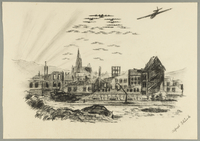
Autobiographical drawing of bombed villages created by Alfred Glück in Hasenhecke DP camp
Object
Charcoal drawing created by Alfred Glück in 1945-46 in the Hackensecke displaced persons camp in Germany. While at the Bergen Belsen DP camp, Alfred was encouraged by a Czech officer working for UNRRA to make drawings depicting scenes he had witnessed during the war. In 1939, eighteen year old Alfred had left Vienna after the annexation of Austria by Nazi Germany in March 1938. He went to Germany to receive agricultural training at a Hechalutz hachshara in preparation for emigration to Palestine. In 1940, he was sent with other group members to Denmark to work as an agricultural laborer on Danish farms. In 1943, he joined a Hechalutz cell, Der Neue Weg, which had a plan to emigrate illegally to Palestine. The young men stowed away on freight railcars leaving Denmark for Turkey. Alfred was caught by the Germans on the Swiss-German border and sent to Auschwitz concentration camp, and then to Jaworno subcamp. In early 1945, he underwent two death marches, first to Buchenwald, and then to Bissengen, where he was freed by French soldiers. He settled briefly in Hamburg, then went to the UNRRA displaced persons camp in Bergen Belsen. In 1946, Alfred emigrated to Palestine. The drawing was given to Mordecai E. Schwartz, a former US Army soldier, who served as the Area Director for the United Nations Relief and Rehabilitation Administration (UNRRA) from 1945-1948, when UNRRA was deactivated.
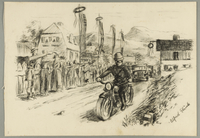
Autobiographical drawing of people celebrating liberation created by Alfred Glück in Hasenhecke DP camp
Object
Charcoal drawing created by Alfred Glück in 1945-46 in the Hackensecke displaced persons camp in Germany. While at the Bergen Belsen DP camp, Alfred was encouraged by a Czech officer working for UNRRA to make drawings depicting the things he had witnessed during the war. In 1939, eighteen year old Alfred had left Vienna after the annexation of Austria by Nazi Germany in March 1938. He went to Germany to receive agricultural training at a Hechalutz hachshara in preparation for emigration to Palestine. In 1940, he was sent with other group members to Denmark to work as an agricultural laborer on Danish farms. In 1943, he joined a Hechalutz cell, Der Neue Weg, which had a plan to emigrate illegally to Palestine. The young men stowed away on freight railcars leaving Denmark for Turkey. Alfred was caught by the Germans on the Swiss-German border and sent to Auschwitz concentration camp, and then to Jaworno subcamp. In early 1945, he underwent two death marches, first to Buchenwald, and then to Bissengen, where he was freed by French soldiers. He settled briefly in Hamburg, then went to the UNRRA displaced persons camp in Bergen Belsen. In 1946, Alfred emigrated to Palestine. The drawing was given to Mordecai E. Schwartz, a former US Army soldier, who served as the Area Director for the United Nations Relief and Rehabilitation Administration (UNRRA) from 1945-1948, when UNRRA was deactivated.
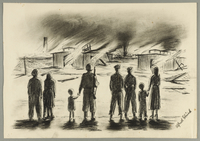
Autobiographical drawing of an allied soldier and a concentration camp inmate created byAlfred Glück in Hasenhecke DP camp
Object
Charcoal drawing created by Alfred Glück in 1945-46 in the Hackensecke displaced persons camp in Germany. While at the Bergen Belsen DP camp, Alfred was encouraged by a Czech officer working for UNRRA to make drawings depicting the things he had witnessed during the war. In 1939, eighteen year old Alfred had left Vienna after the annexation of Austria by Nazi Germany in March 1938. He went to Germany to receive agricultural training at a Hechalutz hachshara in preparation for emigration to Palestine. In 1940, he was sent with other group members to Denmark to work as an agricultural laborer on Danish farms. In 1943, he joined a Hechalutz cell, Der Neue Weg, which had a plan to emigrate illegally to Palestine. The young men stowed away on freight railcars leaving Denmark for Turkey. Alfred was caught by the Germans on the Swiss-German border and sent to Auschwitz concentration camp, and then to Jaworno subcamp. In early 1945, he underwent two death marches, first to Buchenwald, and then to Bissengen, where he was freed by French soldiers. He settled briefly in Hamburg, then went to the UNRRA displaced persons camp in Bergen Belsen. In 1946, Alfred emigrated to Palestine. The drawing was given to Mordecai E. Schwartz, a former US Army soldier, who served as the Area Director for the United Nations Relief and Rehabilitation Administration (UNRRA) from 1945-1948, when UNRRA was deactivated.
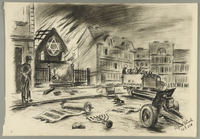
Autobiographical drawing of a burning synagogue created by Alfred Glück in Hasenhecke DP camp
Object
Charcoal drawing created by Alfred Glück in 1945-46 in the Hackensecke displaced persons camp in Germany. While at the Bergen Belsen DP camp, Alfred was encouraged by a Czech officer working for UNRRA to make drawings depicting the things he had witnessed during the war. In 1939, eighteen year old Alfred had left Vienna after the annexation of Austria by Nazi Germany in March 1938. He went to Germany to receive agricultural training at a Hechalutz hachshara in preparation for emigration to Palestine. In 1940, he was sent with other group members to Denmark to work as an agricultural laborer on Danish farms. In 1943, he joined a Hechalutz cell, Der Neue Weg, which had a plan to emigrate illegally to Palestine. The young men stowed away on freight railcars leaving Denmark for Turkey. Alfred was caught by the Germans on the Swiss-German border and sent to Auschwitz concentration camp, and then to Jaworno subcamp. In early 1945, he underwent two death marches, first to Buchenwald, and then to Bissengen, where he was freed by French soldiers. He settled briefly in Hamburg, then went to the UNRRA displaced persons camp in Bergen Belsen. In 1946, Alfred emigrated to Palestine. The drawing was given to Mordecai E. Schwartz, a former US Army soldier, who served as the Area Director for the United Nations Relief and Rehabilitation Administration (UNRRA) from 1945-1948, when UNRRA was deactivated.
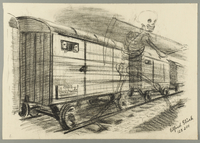
Allegorical, autobiographical drawing of a train transport to Auschwitz created by Alfred Glück in Hasenhecke DP camp
Object
Charcoal drawing created by Alfred Glück in 1945-46 in the Hackensecke displaced persons camp in Germany. While at the Bergen Belsen DP camp, Alfred was encouraged by a Czech officer working for UNRRA to make drawings depicting the things he had witnessed during the war. In 1939, eighteen year old Alfred had left Vienna after the annexation of Austria by Nazi Germany in March 1938. He went to Germany to receive agricultural training at a Hechalutz hachshara in preparation for emigration to Palestine. In 1940, he was sent with other group members to Denmark to work as an agricultural laborer on Danish farms. In 1943, he joined a Hechalutz cell, Der Neue Weg, which had a plan to emigrate illegally to Palestine. The young men stowed away on freight railcars leaving Denmark for Turkey. Alfred was caught by the Germans on the Swiss-German border and sent to Auschwitz concentration camp, and then to Jaworno subcamp. In early 1945, he underwent two death marches, first to Buchenwald, and then to Bissengen, where he was freed by French soldiers. He settled briefly in Hamburg, then went to the UNRRA displaced persons camp in Bergen Belsen. In 1946, Alfred emigrated to Palestine. The drawing was given to Mordecai E. Schwartz, a former US Army soldier, who served as the Area Director for the United Nations Relief and Rehabilitation Administration (UNRRA) from 1945-1948, when UNRRA was deactivated.
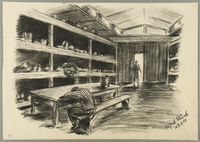
Autobiographical drawing of concentration camp inmates in a barracks created by Alfred Glück in Hasenhecke DP camp
Object
Charcoal drawing created by Alfred Glück in 1945-46 in the Hackensecke displaced persons camp in Germany. While at the Bergen Belsen DP camp, Alfred was encouraged by a Czech officer working for UNRRA to make drawings depicting the things he had witnessed during the war. In 1939, eighteen year old Alfred had left Vienna after the annexation of Austria by Nazi Germany in March 1938. He went to Germany to receive agricultural training at a Hechalutz hachshara in preparation for emigration to Palestine. In 1940, he was sent with other group members to Denmark to work as an agricultural laborer on Danish farms. In 1943, he joined a Hechalutz cell, Der Neue Weg, which had a plan to emigrate illegally to Palestine. The young men stowed away on freight railcars leaving Denmark for Turkey. Alfred was caught by the Germans on the Swiss-German border and sent to Auschwitz concentration camp, and then to Jaworno subcamp. In early 1945, he underwent two death marches, first to Buchenwald, and then to Bissengen, where he was freed by French soldiers. He settled briefly in Hamburg, then went to the UNRRA displaced persons camp in Bergen Belsen. In 1946, Alfred emigrated to Palestine. The drawing was given to Mordecai E. Schwartz, a former US Army soldier, who served as the Area Director for the United Nations Relief and Rehabilitation Administration (UNRRA) from 1945-1948, when UNRRA was deactivated.
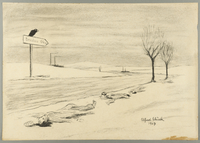
Autobiographical drawing of inmates on a death march created by Alfred Glück in Hasenhecke DP camp
Object
Charcoal drawing created by Alfred Glück in 1945-46 in the Hackensecke displaced persons camp in Germany. While at the Bergen Belsen DP camp, Alfred was encouraged by a Czech officer working for UNRRA to make drawings depicting the things he had witnessed during the war. In 1939, eighteen year old Alfred had left Vienna after the annexation of Austria by Nazi Germany in March 1938. He went to Germany to receive agricultural training at a Hechalutz hachshara in preparation for emigration to Palestine. In 1940, he was sent with other group members to Denmark to work as an agricultural laborer on Danish farms. In 1943, he joined a Hechalutz cell, Der Neue Weg, which had a plan to emigrate illegally to Palestine. The young men stowed away on freight railcars leaving Denmark for Turkey. Alfred was caught by the Germans on the Swiss-German border and sent to Auschwitz concentration camp, and then to Jaworno subcamp. In early 1945, he underwent two death marches, first to Buchenwald, and then to Bissengen, where he was freed by French soldiers. He settled briefly in Hamburg, then went to the UNRRA displaced persons camp in Bergen Belsen. In 1946, Alfred emigrated to Palestine. The drawing was given to Mordecai E. Schwartz, a former US Army soldier, who served as the Area Director for the United Nations Relief and Rehabilitation Administration (UNRRA) from 1945-1948, when UNRRA was deactivated.
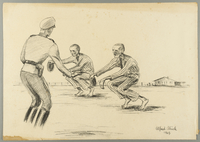
Autobiographical drawing of concentration camp inmates being punished by a guard created by Alfred Glück in Hasenhecke DP persons camp
Object
Charcoal drawing created by Alfred Glück in 1945-46 in the Hackensecke displaced persons camp in Germany. While at the Bergen Belsen DP camp, Alfred was encouraged by a Czech officer working for UNRRA to make drawings depicting the things he had witnessed during the war. In 1939, eighteen year old Alfred had left Vienna after the annexation of Austria by Nazi Germany in March 1938. He went to Germany to receive agricultural training at a Hechalutz hachshara in preparation for emigration to Palestine. In 1940, he was sent with other group members to Denmark to work as an agricultural laborer on Danish farms. In 1943, he joined a Hechalutz cell, Der Neue Weg, which had a plan to emigrate illegally to Palestine. The young men stowed away on freight railcars leaving Denmark for Turkey. Alfred was caught by the Germans on the Swiss-German border and sent to Auschwitz concentration camp, and then to Jaworno subcamp. In early 1945, he underwent two death marches, first to Buchenwald, and then to Bissengen, where he was freed by French soldiers. He settled briefly in Hamburg, then went to the UNRRA displaced persons camp in Bergen Belsen. In 1946, Alfred emigrated to Palestine. The drawing was given to Mordecai E. Schwartz, a former US Army soldier, who served as the Area Director for the United Nations Relief and Rehabilitation Administration (UNRRA) from 1945-1948, when UNRRA was deactivated.
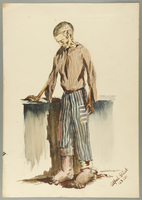
Autobiographical watercolor of a death march survivor with bleeding feet created by Alfred Glück in Hasenhecke DP camp
Object
Watercolor drawing created by Alfred Glück in 1945-46 in the Hackensecke displaced persons camp in Germany. While at the Bergen Belsen DP camp, Alfred was encouraged by a Czech officer working for UNRRA to make drawings depicting the things he had witnessed during the war. In 1939, eighteen year old Alfred had left Vienna after the annexation of Austria by Nazi Germany in March 1938. He went to Germany to receive agricultural training at a Hechalutz hachshara in preparation for emigration to Palestine. In 1940, he was sent with other group members to Denmark to work as an agricultural laborer on Danish farms. In 1943, he joined a Hechalutz cell, Der Neue Weg, which had a plan to emigrate illegally to Palestine. The young men stowed away on freight railcars leaving Denmark for Turkey. Alfred was caught by the Germans on the Swiss-German border and sent to Auschwitz concentration camp, and then to Jaworno subcamp. In early 1945, he underwent two death marches, first to Buchenwald, and then to Bissengen, where he was freed by French soldiers. He settled briefly in Hamburg, then went to the UNRRA displaced persons camp in Bergen Belsen. In 1946, Alfred emigrated to Palestine. The drawing was given to Mordecai E. Schwartz, a former US Army soldier, who served as the Area Director for the United Nations Relief and Rehabilitation Administration (UNRRA) from 1945-1948, when UNRRA was deactivated.
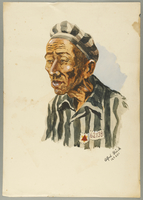
Watercolor portrait of a concentration camp survivor created by fellow inmate Alfred Glück in Hasenhecke DP camp
Object
Watercolor portrait created by Alfred Glück in 1945-46 in the Hackensecke displaced persons camp in Germany. While at the Bergen Belsen DP camp, Alfred was encouraged by a Czech officer working for UNRRA to make drawings depicting the things he had witnessed during the war. In 1939, eighteen year old Alfred had left Vienna after the annexation of Austria by Nazi Germany in March 1938. He went to Germany to receive agricultural training at a Hechalutz hachshara in preparation for emigration to Palestine. In 1940, he was sent with other group members to Denmark to work as an agricultural laborer on Danish farms. In 1943, he joined a Hechalutz cell, Der Neue Weg, which had a plan to emigrate illegally to Palestine. The young men stowed away on freight railcars leaving Denmark for Turkey. Alfred was caught by the Germans on the Swiss-German border and sent to Auschwitz concentration camp, and then to Jaworno subcamp. In early 1945, he underwent two death marches, first to Buchenwald, and then to Bissengen, where he was freed by French soldiers. He settled briefly in Hamburg, then went to the UNRRA displaced persons camp in Bergen Belsen. In 1946, Alfred emigrated to Palestine. The drawing was given to Mordecai E. Schwartz, a former US Army soldier, who served as the Area Director for the United Nations Relief and Rehabilitation Administration (UNRRA) from 1945-1948, when UNRRA was deactivated.
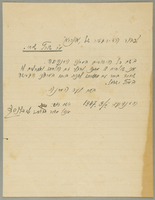
Handwritten thank you note received by an administrator of a displaced persons camp
Object
Handwritten letter received by Mordecai Schwartz on February 9, 1947, from a resident in Hasenhecke displaced persons camp, expressing appreciation for Schwartz's work. Schwartz, a soldier in the United States Army, was who was recruited after the war ended in May 1945 to serve as Area Director for the United Nations Relief and Rehabilitation Administration (UNRRA). He worked for UNRRA until 1948, when UNRRA was deactivated. He then became Area Director for the International Refugee Organization (IRO), supervising twenty-eight displaced persons camps in Germany. The DP camps were set up to house and feed, and to provide medical service and legal protection for survivors of the concentration and slave labor camps, and to offer them the chance to reestablish their lives postwar. When IRO was deactivated in 1951, Mordecai was recruited by US Air Force Intelligence.
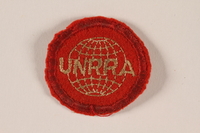
Circular red cloth UNRRA badge worn by a former US soldier as Area Administrator for Germany
Object
UNRRA (United Nations Relief and Rehabilitation Administration) red circle patch worn by Mordecai E. Schwart. Schwartz, a soldier in the United States Army, was recruited after the war ended in May 1945 to serve as Area Director for UNRRA. He worked for UNRRA until 1948, when the organization was deactivated. He then became Area Director for the International Refugee Organization (IRO), supervising twenty-eight displaced persons camps in Germany. The DP camps were set up to house and feed, and to provide medical service and legal protection for survivors of the concentration and slave labor camps, and to offer them the chance to reestablish their lives postwar. When IRO was deactivated in 1951, Mordecai was recruited by US Air Force Intelligence.
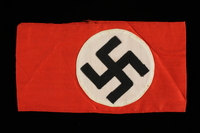
Nazi armband with a swastika acquired by a US soldier
Object
Nazi swastika armband acquired by Mordecai E. Schwart. Schwartz, a soldier in the United States Army. After the war ended in May 1945, Schwartz was recruited to serve as Area Director for UNRRA (United Nations Relief and Rehabilitation Administration). He worked for UNRRA until 1948, when the organization was deactivated. He then became Area Director for the International Refugee Organization (IRO), supervising twenty-eight displaced persons camps in Germany. The DP camps were set up to house and feed, and to provide medical service and legal protection for survivors of the concentration and slave labor camps, and to offer them the chance to reestablish their lives postwar. When IRO was deactivated in 1951, Mordecai was recruited by US Air Force Intelligence.



